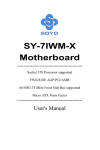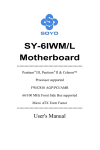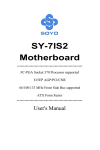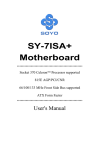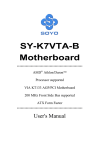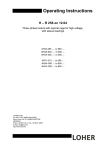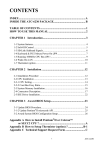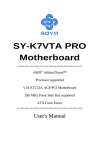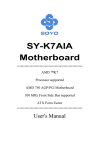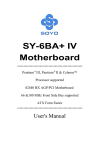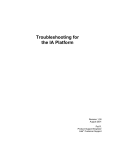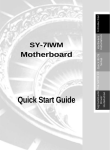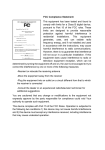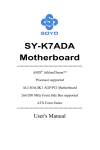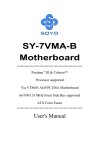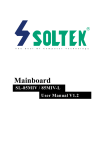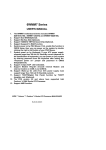Download - Motherboards.org
Transcript
SOYO LI-7000 LPX SYSTEM **************************************************** Socket 370 Celeron Processor supported FW82810 AGP/PCI/AMR Chipset 66/100 MHz Front Side Bus supported Custom LPX Form Factor **************************************************** User's Manual SOYO ™ LI-7000 Copyright © 1999 bySoyo Computer Inc. Trademarks: Soyo is the registered trademark of Soyo Computer Inc. All trademarks are the properties of their owners. Product Rights: All names of the product and corporate mentioned in this publication are used for identification purposes only. The registered trademarks and copyrights belong to their respective companies. Copyright Notice: All rights reserved. This manual has been copyrighted by Soyo Computer Inc. No part of this manual may be reproduced, transmitted, transcribed, translated into any other language, or stored in a retrieval system, in any form or by any means, such as by electronic, mechanical, magnetic, optical, chemical, manual or otherwise, without permission in writing from Soyo Computer Inc. Disclaimer: Soyo Computer Inc. makes no representations or warranties regarding the contents of this manual. We reserve the right to amend the manual or revise the specifications of the product described in it from time to time without obligation to notify any person of such revision or amend. The information contained in this manual is provided to our customers for general use. Customers should be aware that the personal computer field is subject to many patents. All of our customers should ensure that their use of our products does not infringe upon any patents. It is the policy of Soyo Computer Inc. to respect the valid patent rights of third parties and not to infringe upon or to cause others to infringe upon such rights. Restricted Rights Legend: Use, duplication, or disclosure by the Government is subject to restrictions set forth in subparagraph (c)(1)(ii) of the Rights in Technical Data and Computer Software clause at 252.277-7013. About This Guide: This Quick Start Guide can help system manufacturers and end users in setting up and installing the Motherboard. Information in this guide has been carefully checked for reliability; however, to the correctness of the contents there is no guarantee given. The information in this document is subject to amend without notice. For further information, please visit our Web Site on the Internet. The address is "http://www.soyo.com.tw". Tested To Comply With FCC Standards FOR HOME OR OFFICE USE C FC Edition: August 1999 Version 1.0 LI-7000 SERIAL 100% ii POST CONSUMER RECYCLED PAPER Table of Contents LI-7000 Table of Contents CHAPTER 1 INTRODUCTION..............................................................1 1-1 1-2 1-3 KEY FEATURES .............................................................1 LI-7000 SYSTEM ILLUSTRATION ................................1 UMPACKING ..................................................................4 CHAPTER 2 MOTHERBOARD DESCRIPTION ...................................5 2-1 2-2 2-3 2-4 2-5 2-6 2-7 2-8 2-9 2-10 INTRODUCTION ............................................................5 KEY FEATURES .............................................................5 HANDLING THE MOTHERBOARD ..............................7 ELECTROSTATIC DISCHARGE PRECAUTIONS .........7 SY-7IWL-T MOTHERBOARD COMPONENTS .............8 CHIPSET .......................................................................10 I/O INTERFACE CONTROLLER ..................................16 AUDIO SUBSYSTEM ...................................................18 HARDWARE MONITOR...............................................18 WAKE ON LAN TECHNOLOGY..................................19 CHAPTER 3 HARDWARE INSTALLATION .......................................20 3-1 3-2 3-2.1 3-2.2 3-2.3 PREPARATIONS ...........................................................20 INSTALLATION GUIDE ...............................................21 CPU Installation............................................................. 22 SDRAM Memory Module Installation.............................. 24 Motherboard Connector.................................................. 26 3-2.4 3-2.5 3-2.6 3-2.7 3-2.8 3-2.9 Jumpers Setting .............................................................. 42 CMOS Clearing (JP5)..................................................... 43 Power On ....................................................................... 43 Quick BIOS Setup ........................................................... 44 Troubleshooting at Fist Start ........................................... 46 Power Off ....................................................................... 47 CHAPTER 4 BIOS SETUP UTILITY ...................................................48 iii Table of Contents 4-1 4-2 4-3 4-4 4-5 4-6 4-7 4-8 4-9 4-10 4-11 4-12 4-13 LI-7000 SOYO COMBO SETUP.................................................51 STANDARD CMOS SETUP ..........................................55 ADVANCED BIOS FEATURES.....................................58 ADVANCED CHIPSET FEATURES..............................62 INTEGRATED PERIPHERALS .....................................64 POWER MANAGEMENT SETUP ................................68 PNP/PCI CONFIGURATION SETUP.............................71 PC HEALTH STATUS....................................................74 LOAD OPTIMIZED DEFAULTS...................................76 LOAD FAIL-SAFE DEFAULTS.....................................77 SUPERVISOR PASSWORD...........................................78 USER PASSWORD........................................................79 IDE HDD AUTO DETECTION .....................................80 CHAPTER 5 DRIVERS INSTALLATION ............................................81 CHAPTER 6 SIGMATEL AUDIO DRIVER INSTALLATION..............86 CHAPTER 7 REALTEK LAN DRIVER INSTALLATION....................89 iv Introduction LI-7000 Chapter 1 INTRODUCTION 1-1 KEY FEATURES Ø LPX Form Factor 36.3(d) x 31.5(w) x 8.5(H) cm Ø 150W (Max.) SFX Switching Power Supply Ø Screw less & Wire-Free Front Panel Ø Detachable Logo Plate Ø 1 x FDD, 1 x HDD (hidden), 1 x CD-ROM drive bay Ø Detachable Drive Bracket Ø Riser Card for 1 x PCI and 1 x AMR slot Expansion 1-2 LI-7000 SYSTEM ILLUSTRATION Figure 1. Front Panel Floppy Drive Mounting Bay Power Button CD-ROM Mounting Bay Power LED HDD LED LAN LED USB Ports LINE-OUT LINE-IN MIC JACK IR Windows 1 Detachable Loge Plate Introduction LI-7000 Figure 2. Back Panel Game Port LAN LINE-OUT Keyboard Serial Port Mouse Figure 3. Inside Look 150W SFX Power Supply CD-ROM HDD Riser Card FDD Socket 370 CPU 2 Parallel Port TV-OUT S-OUT VGA Port Introduction LI-7000 1. SY-7IWL-T Motherboard Layout ATX Power LAN Connector Game Port LINE-OUT LAN Chip Realtek 8139B PS/2 KB Connector J2 J3 JP1 PS/2 Mouse Connector 20 Front Panel Connector 3 1 4 1 4 2 1 1 FDC CODEC AC97 COM1 COM2 1 1 1 IDE 2 IDE 1 AMR PCI Slot 3V Lithium Battery Buzzer 1 3 JP5 CMOS Clear Jumper PRT LPC W83627HF -AW Intel FW82801 J8 JP15 10 10 AV onnector for TV-Out 9 1 2 Intel S-Video Connector FW82810 TV-Out Chip 4 Socket 370 1 JP10 VGA 1 CPUFAN DIMM 2 DIMM 1 2. Front Panel Board To 7IWL-T Motherboard IR Module USB 3. Riser Card LINE-OUT MIC JACK LINE-IN Riser Card PCI Slot AMR Slot 3 Introduction LI-7000 1-3 UNPACKING When unpacking the System, check for the following items: u The LI-7000 System u The Quick Start Guide u The Installation CD-ROM u SOYO 3-in-1 Bonus Pack CD-ROM (Norton AntiVirus, Ghost and Virtual Drive) u Power Cord Like most electronic equipment, your Motherboard and other components and devices may be damaged by electrostatic discharge. To avoid permanent damage to components ground yourself while working by using a grounding strap. Otherwise, ground yourself frequently by touching the unpainted portion of the computer chassis to drain the static charges. 4 Motherboard Description LI-7000 Chapter 2 MOTHEBOARD DESCRIPTION 2-1 INTRODUCTION The SY-7IWL-T AGP/PCI/AMR Motherboard is a high-performance Socket 370 processor supported Custom LPX form-factor system board. SY-7IWL-T uses the FW82810 Chipset technology and supports Socket 370 processors. This Motherboard is fully compatible with industry standards and adds many technical enhancements. 2-2 KEY FEATURES Ø Supports Intel Celeron ™processors (300A-500MHz) Ø Supports 100 & 66 MHz Front Side Bus Frequency Ø Auto detect CPU bus Frequency (66/100) Ø Auto-detect CPU voltage Ø Chipset integrated 3D AGP Accelerator Ø Easy CPU settings in BIOS with the “SOYO COMBO Setup” Ø PC98, ACPI Ø Ultra DMA33/66 (ATA 33/66) Ø Supports ACPI Suspend Indicator Ø Power-on by modem, alarm, PS/2 Keyboard and Mouse Ø Supports Wake-On-LAN Function Ø Supports Onboard PCI LAN Realtek 8139B 10/100Mb/s Ø Supports TV-out (NTSC/PAL) Ø Supports AC97 Codec software audio Ø Supports onboard hardware monitoring and includes Hardware Doctor ™utility Ø Power failure resume 5 Motherboard Description LI-7000 Ø Fan speed control Ø Battery Low voltage Detect Ø Support 7 sets of voltage monitoring Ø Supports multiple-boot function Ø Y2K Complaint Ø Supports Audio Modem Riser slot (AMR 1.0 compliant) Ø 1 x 32-bit bus mastering PCI slot Ø 2 x USB ports onboard Ø 1 x IrDA Device Ø ATX power connector Ø Hardware Random Number Generator (RNG) for enabling enhanced platform security Ø RTC hardware to handle Y2K Century Rollover * If the user wants to use a Modem Riser card (MR) make sure to use a Secondary mode MR, PRIMARY mode MRs are NOT Supported. 6 Motherboard Description 2-3 LI-7000 HANDLING THE MOTHERBOARD To avoid damage to your Motherboard, follow these simple rules while unpacking: Ø Before handling the Motherboard, ground yourself by grasping an unpainted portion of the system's metal chassis. Ø Remove the Motherboard from its anti-static packaging. Hold the Ø Motherboard by the edges and avoid touching its components. Check the Motherboard for damage. If any chip appears loose, press carefully to seat it firmly in its socket. Warning: Do not apply power if the Motherboard appears damaged. If there is damage to the board, contact your dealer immediately. 2-4 ELECTROSTATIC DISCHARGE PRECAUTIONS Make sure to ground yourself before handling the Motherboard or other system components. Electrostatic discharge can easily damage the components. Note that you must take special precautions when handling the Motherboard in dry or air-conditioned environment. To protect your equipment from electrostatic discharge, take the following precautions: Ø Do not remove the anti-static packaging until you are ready to install. Ø Ground yourself before removing any system component from its protective anti-static packaging. (To ground yourself, grasp the expansion slot covers or other unpainted portions of the computer chassis.) Ø Frequently ground yourself while working or use a grounding strap. Ø Handle the Motherboard by its edges and avoid touching its components. 7 Motherboard Description LI-7000 2-5 SY-7IWL-T MOTHERBOARD COMPONENTS A B C D E F GH I J K L M N O P Z Q R S YX V U 8 T Motherboard Description A B C D E F G H I J K L M N O P Q R S T U V W X Y Z LI-7000 Winbond W83627HF-AW LPC I/O Chip Power-On by Keyboard Jumper Game Port Connector COM1/COM2 Connector Realtek 8139B LAN Chip AC97 Codec Chip CD-IN Connector Front panel connectors Floppy Disk Drive (FDD) Port ATX Power Supply Connector Bus Mastering E-IDE/ATAPI Ports 3V Lithium Battery CMOS Clear Jumper Buzzer Riser-Card Slot Socket 370 Connector Power-button & Front Panel LED Connector Speaker Connector CPU Cooling Fan Connector Intel FW82810 GMCH Chip DIMM Sockets Intel 82802AB 4Mb FWH Chip TV-Out Chip TV-Out Signal Format Jumper Intel FW82801 ICH Chip Back panel Connectors 9 Motherboard Description LI-7000 2-6 CHIPSET To compliment the Intel ®Celeron processor, the Intel ® 810 chipsets delivers a balanced platform solution for value computing. The 810 chipset is a highly-integrated three-chip solution consisting of a Graphics & Memory Controller (Intel 82810), an I/O Controller (Intel82801), and a Firmware Hub (Intel 82802). The ICH is a highly integrated multifunctional I/O Controller Hub that provides the interface to the PCI Bus and integrates many of the functions needed in today PC platforms. The ICH communicates with the host controller over a dedicated hub interface. There are two versions of the ICH (82801AA: ICH and 82801AB: ICH0). These devices are pin compatible and are in 241-pin packages. The Intel ® 82802 Firmware Hub (FWH) component is part of the Intel ® 810 chipset. The FWH is key to enabling future security and manageabilily infrastructures for the PC platform. Intel has developed technology that enhances the performance and exceptional value of the Intel ®Celeron ™processor-powered PC. Built on the strong foundation of Intel ® 440BXAGPset technology, the Intel ® 810 chipset has re-engineered the Value PC, providing next generation features and great graphics performance at a lower cost. Richer, more robust 2D and 3D graphics are optimized thanks to an integrated chipset design that utilizes second-generation graphics technology. This integrated chipset offers innovative features with compelling performance while lowering overall system costs. A new design with big benefits At the core of the 810 chipset is a memory controller with built-in graphics 10 Motherboard Description LI-7000 technology. The 82810 chip optimizes system memory arbitration, similar to AGP technology, resulting in a more responsive and cost-effective system. The 82810 Graphics Memory Controller Hub (GMCH) features Intel ® graphics technology and software drivers, using Direct AGP (integrated AGP) to create vivid 2D and 3D effects and images. The 82810 chip features integrated Hardware Motion Compensation to improve soft DVD video quality and a digital video out port that enables connection to traditional TVs or the new space-saving digital flat panel displays. Intel ® Dynamic Video Memory Technology (D.V.M.T.) is an architecture that offers breakthrough performance for the Value PC segment through efficient memory utilization and Direct AGP. The system OS uses the Intel software drivers and intelligent memory arbiter to support richer graphics applications. The System Manageability Bus allows networking equipment to monitor the 810 chipset platform. Using ACPI specifications, the system manageability function enables low-power sleep mode and conserves energy when the system is idle. The 82801 I/O Controller Hub (ICH) employs the Intel ® Accelerated Hub Architecture to make a direct connection from the graphics and memory to the integrated AC97 controller, the IDE controllers, dual USB ports, and PCI add-in cards. The Accelerated Hub Architecture provides twice the bandwidth of the PCI bus at 266 MB per second. This allows a wider flow of rich information from the I/O controller to the memory controller, with optimized arbitration rules allowing more functions to run concurrently, enabling more life-like audio and video. 11 Motherboard Description LI-7000 The Integrated Audio-Codec 97 controller enables software audio and modem by using the processor to run sound and modem software. By reusing existing system resources, this feature adds flexibility, and improves sound quality. The 82802 Firmware Hub (FWH) stores system BIOS and video BIOS, eliminating a redundant nonvolatile memory component. In addition, the 82802 contains a hardware Random Number Generator (RNG). The Intel ® RNG provides truly random numbers to enable fundamental security building blocks supporting stronger encryption, digital signing, and security protocols. Intel 810 chipset re-engineers the Value PC by providing a platform that will bring next generation features and great graphics performance to Value PC while reducing overall platform cost. PRODUCT HIGHLIGHTS Ø Enhances performance and exceptional value of the Intel ®Celeron™ processor-powered PC Ø Built on strong foundation of Intel ® 440Bx technology Ø Provides next generation features Ø Provides great graphics performance at a lower cost Ø Optimizes 2D and 3D graphics through integrated chipset design Ø utilizing second-generation graphics technology Innovative features with compelling performance while lowering system costs FEATURES BENEFITS Ø Intel ® Accelerated Hub Architecture Increased I/O performance allows better concurrency for richer multimedia applications Ø Integrated graphics/AC97 controller, more flexibility and better audio Ø quality Intel ® 3D graphics with Direct AGP Vivid 2D and 3D graphics, 12 Motherboard Description Ø Ø Ø Ø Ø Ø Ø Ø Ø LI-7000 efficient use of system memory for graphics, O/S and applications Optional 4MB of dedicated display cache video memory Enables SKU differentiation with increased 3D graphics performance improvement over Direct AGP Low-power sleep modes Energy Savings One software driver code base More stable platform, higher quality graphics, reduced OEM support costs Intel ® Random Number Generator (RNG) EnablesISV's to strengthen security products Digital Video Out port Allows connection of traditional TV or new digital flat panel displays; compatible with DVI specification Soft DVD MPEG 2 playback with Hardware Motion Compensation Life-like video and audio 100-MHz System Bus capable Flexibility for performance headroom 2 USB ports Plug and Play Multiple Intel ® 810 chipsetSKUs for Value PC price points Lower platform and manufacturing costs with single motherboard design Product Package Ø 82810 Graphics Memory Controller Hub 421 Ball Grid Array (BGA) Ø 82801 Integrated Controller Hub 241 Ball Grid Array (BGA) Ø 82802 Firmware Hub 32-pin PLCC or 40-pin TSOP 2-6.1 Accelerated Graphics Port (A.G.P.) A.G.P. is a high-performance bus for graphics-intensive applications, such as 3D applications. A.G.P., while based on the PCI Local Bus Specifications, Rev 2.1, is independent of the PCI bus and is intended for exclusive use with graphical display devices. A.G.P. overcomes certain limitations of the PCI bus related to handling a large amount of graphics data with the following features: l Pipelined memory read and write operations that hide memory access 13 Motherboard Description l l LI-7000 latency Demultiplexing of address and data on the bus for near 100 percent bus efficiency AC timing for 133 MHz data transfer rates, allowing real data throughput in excess of 500 MB/sec 2-6.2 Universal Serial Bus (USB) The motherboard has two USB ports; one USB peripheral can be connected to each port. For more than two USB devices, an external hub can be connected to either port. The motherboard fully supports the universal host controller interface (UHCI) and used UHCI-compatible software drivers. Specification USB features include: l Self-identifying peripherals that can be plugged in while the computer is running l l l l l Automatic mapping of function to driver and configuration Support for isochronous and asynchronous transfer types over the same set of wires Support for up to 127 physical devices Guaranteed bandwidth and low latencies appropriate for telephony, audio, and other applications Error-handling and fault-recovery mechanisms built into the protocol ¿ Note Computer systems that have an unshielded cable attached to a USB port may not meet FCC Class B requirements, even if no device or a low-speed USB device is attached to the cable. Use shielded cable that meets the requirements for a full-speed USB device. 14 Motherboard Description LI-7000 2-6.3 IDE Support The motherboard has two independent bus-mastering PCI IDE interfaces. These interfaces support PIO Mode3, PIO Mode 4, ATAPI devices (e.g., CD-ROM), and Ultra DMA/33 synchronous-DMA mode transfers. The BIOS supports logical block addressing (LBA) and extended cylinder head sector (ECHS) translation modes. The BIOS automatically detects the IDE device transfer rate and translation mode. Programmed I/O operations usually require a substantial amount of processor bandwidth. However, in multitasking operating systems, the bandwidth freed by bus mastering IDE can be devoted to other tasks while disk transfers are occurring. The motherboard also supports laser servo (LS-120) drives. LS-120 technology allows the user to perform read/write operations to LS-120 (120MB) and conventional 1.44MB and 720KB diskettes. An optical servo system is used to precisely position a dual-gap head to access the diskett’s 2,490 tracks per inch (tpi) containing up to 120 MB of data storage. A conventional diskette uses 135 tpi for 1.44 MB of data storage. LS-120 drivers are ATAPI-compatible and connect to the motherboard’s IDE interface. (LS-120 drives are also available with SCJSI and parallel port interfaces.) Some versions of Windows 95 and Windows NT operating systems recognize the LS-120 drive as a bootable device in both 120 MB and 1.44 MB mode. Connection of an LS-120 drive and a standard 3.5-inch diskette drive is allowed. The LS-120 drive can be configured as a boot device if selected as Drive A in the BIOS setup program. ¿ Note If you connect at LS-120 drive to an IDE connector and configure it as the :boot: drive and configure a standard 3.5-inch diskette drive as a “B ” drive, the standard diskette drive is not seen by the operating system. When the LS-120 drive is configured as the “boot: device, the system will recognize it as both the A and B drive 15 Motherboard Description LI-7000 2-6.4 Real-Time Clock, CMOS SRAM, and Battery The real-time clock is compatible with DS1287 and MC146818 components. The clock provides a time-of-day clock and a multicentury calendar with alarm features and century rollover. The real-time clock supports 256 bytes of battery-backed CMOS SRAM in two banks that are reserved for BIOS use. The time, date, and CMOS values can be specified in the Setup program. The CMOS values can be returned to their defaults by using the Setup program. 2-7 I/O INTERFACE CONTROLLER The motherboard uses the Winbond W83627HF-AW I/O controller which features: l Single diskette drive interface l Two serial ports l l FIFO supports on both serial and diskette interfaces One parallel port with Extended Capabilities Port (ECP) and Enhanced Parallel Port (EPP) support l PS/2 style mouse and keyboard interfaces l PCI PME interface l Intelligent auto power management, including: Ø Shadowed write-only registers for ACPI compliance Ø Programmable wake-up event interface The Setup program provides configuration option for the I/O controller. 2-7.1 Serial Ports The motherboard has one 9-pin D-Sub serial port connector located on the back panel. The NS16C5450-compatible UARTs support data transfers at speeds up to 115.2 Kbits/sec with BIOS support. 2-7.2 Parallel Port The connector for the multimode bi-directional parallel port is a 25-pin DSub connector located on the back panel of the motherboard. In the Setup 16 Motherboard Description LI-7000 program, there are four options for parallel port operation: l Compatible (standard mode) l Bi-directional (PS/2 compatible) l Bi-directional EPP. A driver from the peripheral manufacturer is required for operation. See Section 6.2 for EPP compatibility. l Bi-directional high-speed ECP 2-7.3 Diskette Drive Controller The I/O controller is software compatible with the 82077 diskette drive controller and supports both PC-AT and PS/2 modes. In the Setup program, the diskette drive interface can be configured for the following diskette drive capacities and sizes. l 360 KB, 5.25-inch l 1.2 MB, 5.25-inch l 720 KB, 3.5-inch l l l 1.2 MB. 3.5-inch (driver required) 1.25-1.44 MB, 3.5-inch 2.88 MB, 3.5-inch 2-7.4 PS/2 Keyboard and Mouse Interface PS/2 keyboard and mouse connectors are located on the back panel of the motherboard. The +5 V lines to these connectors are protected with a fuse circuit that, like a self-healing fuse, reestablishes the connection after an over-current condition is removed. ¿ Note The mouse and keyboard can be plugged into either PS/2 connector. Power to the computer should be turned off before a keyboard or mouse is connected or disconnected. The keyboard controller contains code, which provides the traditional keyboard and mouse control functions, and also supports Power On/Reset password protection. Power On/Reset password can be specified in the BIOS Setup program. 17 Motherboard Description LI-7000 The keyboard controller also supports the hot-key sequence <Ctrl><Alt><Del>, software reset. This key sequence resets the computer’s software by jumping to the beginning of the BIOS code and running the Power On Self Test (POST). 2-7.5 Infrared Support The IR connection can be used to transfer files to or from portable devices like laptops, PDAs, and printers. 2-8 AUDIO SUBSYSTEM 2-8.1 Audio Connector The audio connectors include the following: l Back panel connectors: stereo line-level output (Line Out), stereo line-level input (Line In), and Mic In 2-8.1.1 CD Line - in Connector A1 x 4-pin ATAPI-style connector is available for connecting an internal CD-ROM drive to the audio mixer. The connector is designed for use with cables that are compatible with ATAPI CD-ROM drivers 2-9 HARDWARE MONITOR The optional hardware monitor subsystem provides low-cost instrumentation capabilities. The features of the hardware monitor subsystem include: Ø An integrated ambient temperature sensor Ø Fan speed sensors, which monitor the fan 1 and fan 2 connectors Ø Power supply voltage monitoring to detect levels above or below acceptable values When suggested ratings for temperature, fan speed, or voltage are exceeded, an interrupt is activated. The hardware monitor component connects to the SMBus. 18 Motherboard Description LI-7000 2-10 WAKE ON LAN TECHNOLOGY Wake on LAN technology enables remote wakeup of the computer through a network. The LAN subsystem, whether onboard or as a PCI bus network adapter, monitors network traffic at the Media Independent Interface. Upon detecting a Magic Packet= frame, the LAN subsystem asserts a wakeup signal that powers up the computer. Depending on the LAN implementation, the motherboard board supports Wake on LAN technology in one of two ways: Ø Through the Wake on LAN technology connector Ø Through the PCI bus PME# signal (for PCI2.2 compliant LAN designs) The Wake on LAN technology connector can be used with PCI bus network adapters that have a remote wake up connector, Network adapters that are PCI 2.2 compliant assert the wakeup signal through the PCI bus signal PME# (pin A19 on the PCI bus connectors). Note:This motherboard supports remote wakeup using the PME# signal; the WOL connector is not supported. The onboard LAN subsystem also supports remote wakeup using the PME# signal. * CAUTION For Wake on LAN, the 5-V standby line for the power supply must be capable of delivering +5V ±5 % at 720 mA. Failure to provide adequate standby current when implementing Wake on LAN can damage the power supply. 19 Motherboard’s Hardware Installation LI-7000 Chapter 3 MOTHERBOARD’ S HARDWARE INSTALLATION 3-1 PREPARATIONS Gather and prepare all the following hardware equipment to complete the installation successfully: u CeleronTM Socker370 processor with CPU cooling fan* u SDRAM module u Monitor u Keyboard u Mouse u Speaker(s) (optional) u Disk Drives: HDD, CD-ROM, Floppy drive … u External Peripherals: Printer, Plotter, and Modem (optional) u Internal Peripherals: Modem Riser cards (optional) Note: If you want to use an external speaker connected to "Line-out" port, please make sure to use an "amplified speaker" that can generate proper output sound volume. *Please use appropriate fan and heatsink to avoid the mechanical conflict with drive bracket. 20 Motherboard’s Hardware Installation LI-7000 3-2 MOTHERBOARD INSTALLATION GUIDE We will now begin the installation of the Motherboard. Please follow the step-by-step procedure designed to lead you to a complete and correct installation. Warning: Turn off the power to the Motherboard, system chassis, and peripheral devices before performing any work on the Motherboard or system. BEGIN THE INSTALLATION 21 Motherboard’s Hardware Installation LI-7000 3-2.1 CPU Installation To perform the installation of your new SY-7IWL-T Motherboard, follow the steps below: Mark your CPU Frequency: Record the working frequency of your CPU that should be clearly marked on the CPU cover. 300MHz (66 x 4.5) 433MHz (66 x 6.5) 333MHz (66 x 5.0) 466MHz (66 x7..0) 366MHz (66 x 5.5) 500MHz (66 x7.5) 400MHz (66 x 6.0) This Motherboard is designed to support processors with 100MHz FSB. However, Socket 370 processors with 100MHz FSB are not available at present. CPU Mount Procedure: To mount the Celeron TM processor that you have purchased separately, follow these instructions. 1. Lift the socket handle up to a vertical position. 2. Align the blunt edge of the CPU with the matching pinhole distinctive edge on the socket. 22 Motherboard’s Hardware Installation LI-7000 3. Seat the processor in the socket completely and without forcing. 4. Then close the socket handle to secure the CPU in place. Remember to connect the CPU Cooling Fan to the appropriate power connector on the Motherboard. The fan is a key component that will ensure system stability. The fan prevents overheating, therefore prolonging the life of your CPU. 23 Motherboard’s Hardware Installation LI-7000 3-2.2 SDRAM Memory Module Installation DIMM 2 DIMM 1 Your board comes with two DIMM sockets, and supports up to 512MB main memory using industry standard Synchronous DRAM (SDRAM), single or double-sided, 3.3V unbuffered DIMM modules from 8MB to 256MB. Registered DIMMs or DIMMs populated with 4 bit wide SDRAM devices are not supported. PC100 compliant DIMM module is required regardless of 66 or 100MHz FSB speed. 84 1 1 84 24 Motherboard’s Hardware Installation LI-7000 Memory Configuration Table Number of Memory Modules DIMM 1 DIMM 2 1 Double-sided/ Single-sided Double-sided/ Single-sided 2 Double-sided/ Single-sided Double-sided/ Single-sided RAM Type Memory Module Size (MB) SDRAM¹ 8/16/32/64/256 Mbytes Note: PC100 Compliant DIMM module is required regardless of 66 or 100 MHz FSB speed. 25 Motherboard’s Hardware Installation LI-7000 3-2.3 Motherboard Connector IDE 2 IDE 1 Pin -1 Secondary Primary IDE IDE 3-2.3.1 IDE Device Installation (HDD, CD-ROM) This Motherboard offers two primary and secondary IDE device connectors (IDE1, IDE2). It can support up to four high-speed ATA 33/66 HDD or CD-ROM. Connect one side of the 40-pin flat cable to the IDE device (HDD or CDROM) and plug the other end to the primary (IDE1) or secondary (IDE2) directionally keyed IDE connector on the Motherboard. This Motherboard can support up to four ATA 33/66 IDE devices. 80-Conductor ATA 66 Flat Cable 1 40-pin 39 1 39 26 Motherboard’s Hardware Installation LI-7000 3-2.3.2 Floppy Drive Installation Pin -1 FDC Floppy Drive Connector The system supports 5 possible floppy drive types: 720 KB, 1.2 MB, 1.44 MB, 2.88 MB, and LS-120. In addition, this Motherboard supports a 3-mode (720KB/1.2MB/1.44MB) floppy commonly used in Japan. Connect one side of the 34-pin flat cable to the floppy drive and plug the other end to the floppy drive connector on the Motherboard. This Motherboard can support up to 2 floppy drives. 1 33 1 33 27 Motherboard’s Hardware Installation LI-7000 3-2.3.3 Front Panel Connections Front Panel Device : JP16 20 18 16 14 12 10 8 6 4 2 19 17 15 13 11 9 7 5 3 1 Power Button & Front Panel LED: JP15 10 9 8 7 6 5 4 3 2 1 Speaker: JP10 4 3 2 1 1. Front Panel Device: JP16 Plug the computer case's front panel board flat cable connector to this header. The header by out is as follows: USB IrDA GND Microphone USB G1 USB D1P USB D1N USBV1 VCC IRRX ROUT1 GND LINE R1 Mic In 20 18 16 14 12 10 8 6 4 2 19 17 15 13 11 9 7 5 3 1 28 USB G0 USB D0P USB D0N USB V0 VCC IRTX LOUT1 GND LINE L1 Mic PWR VCC LINE-OUT LINE IN Motherboard’s Hardware Installation LI-7000 To 7IWL-T Motherboard IR Module USB LINE-OUT MIC JACK LINE-IN (1). Universal Serial Bus USB1/USB2 This Motherboard provides two USB ports for your additional devices. Plug the USB device jack into the available USB connector USB1 or USB2. - Standard device drivers come with the Win98 for commonly used USB devices. With Win95, use the flow UHCI specifications. (2). Onboard Joystick port/audio This Motherboard provides Joystick port and audio. Attach the joystick cable to the 15-pin JOYSTICK port at the rear panel of you motherboard. This Motherboard features three built-in audio-stereo ports (labeled line-in, line-out, and mic jack) convenient to directly plug-in all your external audio devices. (3). IR Module Your case has a build in IR transceiver, connected to the motherboard through this header. It supports both the ASKIR and HPSIR specifications. 29 Motherboard’s Hardware Installation 2. LI-7000 Power Button & Front Panel LED: JP15 HDD LED ACPI LED IDEACT# 10 SVS LED # 8 NC 6 IOSVSB 4 VCC 2 9 7 5 3 1 VCC PWRBTN#LPC Power Button 5VSB NC LED 0 LAN LED (1). IDE LED Attach the 2-pin IDE device LED cable to the corresponding IDE LED header on the Motherboard. This will cause the LED to lighten when an IDE (HDD, CD-ROM) device is active. HDD LED Pin Assignment Pin9 Pin10 VCC IDEACT# (2). ACPI LED Connecting the 2-pin ACPI LED cable to the corresponding ACPI LED header will cause the LED to light whenever the system is in ACPI mode. The manufacturer has permanently set this Motherboard in ACPI mode due to most hardware and software compliance to ACPI mode. ACPI LED Pin Assignment Pin4 Pin6 Pin8 IO SVSB None 30 SVS LED# Motherboard’s Hardware Installation LI-7000 (3). ATX Power On/Off Switch Attach the 2-pin momentary type switch to the PWRBT header for turning On or Off your ATX power supply. PWRBT Pin Assignment Pin5 Pin7 5VSB PWRBTN#LPC (4). LAN LED Attach the 2-pin LAN LED connector to this header. The LED will light up when data is transfer over the network. LAN LED Pin Assignment Pin1 Pin2 LED 0 VCC 3. Speaker (JP10) Attach the 4-pin PC speaker cable from the case to the Speaker header on the Motherboard. Speaker Pin Assignment _ + +5V Speaker out NC NC 31 Motherboard’s Hardware Installation LI-7000 3-2.3.4 Back Panel Connections All external devices such as the PS/2 keyboard, PS/2 mouse, printer, modem, USB can be plugged directly onto the Motherboard back panel. Only after you have fixed and locked the Motherboard to the computer case can you start connecting the external peripheral devices. When connecting an external device, use the following figure to locate and identify which back panel connector to plug the device to. LAN Connector LINE-OUT PS/2 KB Connector PS/2 Mouse Connector PRT AV onnector for TV-Out S-Video Connector VGA 32 Motherboard’s Hardware Installation LI-7000 1. LAN Connector This is the network connector, supporting 10/100MHz transfer rates. Make sure to use the right quality of cable, 100MHz operation requires special cable, ask you dealer. TX/RX LINK (10/100) 87654321 NCRX- NC RX+ TX- TX+ 2. LINE-OUT This is a stereo output to which external speakers can be connected. Make sure to use only Amplified speakers, otherwise the signal level will be too low. 3. PS/2 Keyboard Plug the keyboard jack directly into the 6-pin female PS/2 keyboard connector located at the rear panel of the Motherboard. Pin6 NC Pin4 VCC Pin2 NC Pin5 KBD Clock Pin3 GND Pin1 KBD DATA 33 Motherboard’s Hardware Installation LI-7000 4. PS/2 Mouse Similarly, plug the mouse jack directly into the 6-pin female PS/2 mouse connector. Pin5 Mouse Clock Pin6 NC Pin4 VCC Pin3 GND Pin1 Mouse DATA Pin2 NC 5. Parallel Port PRT This parallel port is used to connect the printer or other parallel devices. Plug the parallel device cable into the 25-pin female connector located at the rear panel of the Motherboard. 6. AV connector for TV-OUT Connect your television antenna input to this connector. Make sure to first set the signal type to the proper value for you Television (NTSC/ PAL). Under windows this can be changed under display properties after the driver is installed. Signal GND 34 Motherboard’s Hardware Installation LI-7000 7. S-Video This output provides a S-Video signal for devices that support this standard. C Y GND GND 8. VGA monitor connector Plug the monitor cable into the 15-pin female VGA connector located at the real panel of the motherboard. 35 Motherboard’s Hardware Installation LI-7000 3-2.3.5 Other Connections 1. Serial Port COM 1 and COM2 This Motherboard provides two serial port connectors. Plug the 9-pin end of the flat cable into the COM1/COM2 serial port header on the Motherboard, as shown in the figure below, then fix the connector to the rear panel of the computer case. Then plug your serial device cable directly into the 9-pin male connector located at the back of your computer. 9-pin serial flat cable Rear Panel of the computer case COM 1 COM 2 9-pin male external serial connector 36 Motherboard’s Hardware Installation LI-7000 2. CD Line-in (J2,J3) This Motherboard provides two CD-Line in connectors. Please connect the 4-pin audio cable from your CD-ROM drive to either J2 or J3. (It fits in only one, depending on the cable that came with your CD-ROM drive) Please install according to the following pin assignment: J2,J3(CD Line-in) Pin Assigment Left Right GND GND J2 1 Left 2 3 4 GND Right GND J3 1 2 37 3 4 Motherboard’s Hardware Installation 3. LI-7000 Cooling Fan Installation (1) CPU Cooling Fan After you have seated the CPU properly on the processor, attach the 3-pin fan cable to the CPUFAN connector on the Motherboard. The fan will stop when the system enters into Suspend Mode. (Suspend mode can be enabled from the BIOS Setup Utility, [Soyo Combo] menu.) To avoid damage to the system, install according to the following pin assignment: CPU Cooling Fan CPUFAN Pin Assignment 1 GND 3 2 12V 38 SENSOR Motherboard’s Hardware Installation LI-7000 3-2.3.6 AGP VGA Card This motherboard comes with integrated AGP subsystem therefore, AGP VGA card is not needed. Other Display Cards: Insert other types of VGA cards into the PCI or ISA expansion slots according to card specifications. 3-2.3.7 SFX/ATX Power Supply Plug the connector from the power directly into the 20-pin male SFX/ATX PW connector on the Motherboard, as shown in the following figure. SFX/ATX Power Connector 39 Motherboard’s Hardware Installation LI-7000 Warning: Follow these precautions to preserve your Motherboard from any remnant currents when connecting to power supply: Turn off the power supply and unplug the power cord of the power supply before connecting to PW connector. This motherboard requires a power supply, that meets the SFX 1.1 or ATX 2.03 specifications. Make sure the power supply can support at least 720mA on the 5V Standby lead. Please install the SFX/ATX power according to the following pin assignment: SFX/ATX Power 12V 5VSB PW-OK GND 5V GND 5V GND 3.3V 3.3V 5V 5V -5V Ø GND GND Ø GND PS-ON GND -12V 3.3V (ATX only) Pay special care to the directionality. 40 Motherboard’s Hardware Installation LI-7000 3-2.3.8 AMR (Audio Modem Riser) Connector This motherboard supports AMR (Audio-Modem Riser) slot that facilitates audio or modem riser card expansion. Since AC97 audio codec is built-in down on the motherboard, only “Secondary” mode modem riser (MR) card can be used on the AMR slot. Riser Card PCI Slot AMR Slot 41 Motherboard’s Hardware Installation LI-7000 3-2.4 Jumpers Setting 3-2.4.1 Enable/Disable Power-On by Keyboard (JP1) You may choose to enable the Power-On through Keyboard function by shorting pin 1-2 on jumper JP1; or short pin 2-3 to disable this function. Power-On by Keyboard JP1 Setting Enable Disable Short pin 1-2 to enable the PowerOn by Keyboard function. Short pin 2-3 and the Power-On by Keyboard function is disabled. 1 2 3 1 2 3 Important: When using the Power-On by Keyboard function, please make sure the power supply is able to provide at least 720mA on the 5V Standby lead (5VSB). 3-2.4.2 TV-Out signal format (JP8) The TV-Out connector on your motherboard supports the two most important video signal formats. i.e., NTSC and PAL. Use JP8 to set the format used. NTSC is common in the United States, as where PAL is the European standard. Video signal format JP8 Setting NTSC open JP8 PAL short JP8 1 2 1 2 3-2.4.3 AC line input setting AC line input range 115 92~135 Vrms 230 AC Line Input Setting 180~265 Vrms 42 Motherboard’s Hardware Installation LI-7000 Make sure to set the AC line input appropriately based on the local electricity supply. Improper setting may cause the damage of the power supply or system. 3-2.5 CMOS Clearing (JP5) After you have turned off your computer, clear the CMOS memory by momentarily shorting pins 2-3 on jumper JP5, for a few seconds. Then restore JP5 to the initial 1-2 jumper setting in order to recover and retain the default settings. Jumper JP5 can be easily identified by its white colored cap. CMOS Clearing Clear CMOS Data Retain CMOS Data Short pin 1-2 to retain new settings Short pin 2-3 for JP5 Setting at least 5 seconds to clear the CMOS 1 2 3 1 2 3 Note: You must unplug the ATX power cable from the ATX power connector when performing the CMOS Clear operation. 3-2.6 Power On You have now completed the hardware installation of your Motherboard successfully. 1. Turn the power on 2. To enter the BIOS Setup Utility, press the <DEL> key while the system is performing the diagnostic checks. Note: If you have failed to enter the BIOS, wait until the boot up sequence is completed. Then push the RESET button and press <DEL> key again at the beginning of boot-up, during diagnostic checks. 43 Motherboard’s Hardware Installation LI-7000 Repeat this operation until you get the following screen. 3. The BIOS Setup screen appears: CMOS Setup Utility – Copyright ( C ) 1984-1999 Award Software 4Soyo Combo Feature 4PC Health Status 4Standard CMOS Features Load Optimized Defaults 4Advanced BIOS Features Load Fail - Safe Defaults 4Advanced Chipset Features Set Supervisor Password 4Integrated Peripherals Set User Password 4Power Management Setup Save & Exit Setup 4PnP/PCI Configurations Exit Without Saving áâàß Esc : Quit F10 : Save & Exit Setup : Select Item Change CPU’s Clock & Voltage 3-2.7 Quick BIOS Setup This Motherboard does not use any hardware jumpers to set the CPU frequency. Instead, CPU settings are software configurable with the BIOS [Soyo Combo Feature]. The [Soyo Combo Feature] menu combines the main parameters that you need to configure, all in one menu, for a quick setup in BIOS. After the hardware installation is complete, turn the power switch on, then press the <DEL> key during the system diagnostic checks to enter the Award BIOS Setup program. The CMOS SETUP UTILITY will display on screen. Follow these steps to configure the CPU settings. SETUP UTILITY will display on screen. Then, follow these steps to configure the CPU settings. 44 Motherboard’s Hardware Installation LI-7000 Step 1. Select [STANDARD CMOS SETUP] Set [Date/Time] and [Floppy drive type], then set [Hard Disk Type] to “Auto”. Step 2. Select [Load Optimized Defaults] Select the “Load Optimized Defaults” menu and type “Y” at the prompt to load the BIOS optimal setup. Step 3. Select [Soyo Combo Feature] (a) CPU Host/PCI Clock CPU Host / PCI Clock o 66/33 o 70/35 o 75/37 o 83/41 o 90/30 o 95/31 o 100/33 o 105/35 o 114/38 o 120/40 o 124/41 o 133/33 o 133/44 o 140/35 o 150/37 The PCI clock frequency depends on the CPU Host clock. (Fixed pairs in the clock generator) see the table on the left side for all possible pairs. (b) CPU Ratio After you have selected the CPU Host/ PCI Clock, choose the right multiplier for the CPU. CPU Ratio options are: ox2 o x 4.5 ox7 o x 2.5 ox5 o x 7.5 ox3 o x 5.5 ox8 o x 3.5 ox6 ox4 o x 6.5 The CPU frequency is then defined as [host clock freq.] x [multiplier], and should the working frequency of your CPUs processor. Step 4. Select [Save & Exit Setup] Press <Enter> to save the new configuration to the CMOS memory, and continue the boot sequence. 45 Motherboard’s Hardware Installation LI-7000 3-2.8 Troubleshooting at First Start l 1. 2. 3. 4. 5. 6. What should I do if the Motherboard refuses to start? Check that all DIMM memory modules are inserted completely. Sometimes a DIMM that is not inserted properly can cause boot problems. Check whether all Add-on cards have been inserted properly. Reinsert the Add-on cards to make sure that they make proper contact with the slots. Try removing all Add-on cards one by one to see whether or not one of them is causing problems. (Switch the system off before removing any of the cards. Verify that speed settings are not exceeding specifications. This applies to the PCI bus, that is specified to run at 33 MHz. Also check the speed setting for the memory, make sure conservative setting is used. If the CPU is overclocked the system may not start up, read the section below. Make sure that the Harddisk IDE cables are attached properly, if not the system will not boot. In case of doubt try reversing the IDE connector on one end of the cable. Verify that the 110/220V switch on the back of the power supply is set correctly. Go through the jumper setting section again to make sure that all jumpers are set correctly. 46 Motherboard’s Hardware Installation LI-7000 3-2.9 Power Off There are two possible ways to turn off the system: 1. Use the Shutdown command in the Start Menu of Windows 95/98 to turn off your computer. 2. Press the mechanical power-button and hold down for over 4 seconds, to shutdown the computer. If you press the power-button for less than 4 seconds, then your system will enter into Suspend Mode. You are now ready to configure your system with the BIOS setup program. Go to Chapter 4: BIOS SETUP 47 Motherboard’s BIOS Setup Utility LI-7000 Chapter 4 MOTHERBOARD’ S BIOS SETUP UTILITY This Motherboard's BIOS setup program uses the ROM PCI/ISA BIOS program from Award Software Inc. To enter the Award BIOS program's Main Menu: 1. Turn on or reboot the system. 2. After the diagnostic checks, press the [Del] key to enter the Award BIOS Setup Utility. CMOS Setup Utility – Copyright ( C ) 1984-1999 Award Software 4Soyo Combo Feature 4PC Health Status 4Standard CMOS Features Load Optimized Defaults 4Advanced BIOS Features Load Fail - Safe Defaults 4Advanced Chipset Features Set Supervisor Password 4Integrated Peripherals Set User Password 4Power Management Setup Save & Exit Setup 4PnP/PCI Configurations Exit Without Saving áâàß Esc : Quit F10 : Save & Exit Setup : Select Item Change CPU’s Clock & Voltage Selecting items l Use the arrow keys to move between items and select fields. l From the Main Menu press arrow keys to enter the selected submenu. Modifying selected items l Use the [Up]/[Down] keys to modify values within the selected fields. Some fields let you enter values directly. 48 Motherboard’s BIOS Setup Utility LI-7000 Hot Keys: Function keys give you access to a group of commands throughout the BIOS utility. Function Command Description Gives the list of options available for each F1 General Help item. Previous Restore the old values. These are the values F5 Values that the user started the current session with. Load FailLoads all items with the most conservative F6 Safe Defaults values. Load F7 Optimized Loads all options with the optimize values. Defaults F10 Save Saves your changes and reboots the system. Returns at anytime and from any location to [Esc] Exit the Main Menu. Will display a overlapping window with all [Enter] Select options for the current item. Using the +, –, Page Up and Page Down [+/–/PU/PD] Value keys the user can toggle the value of the current item. 49 Motherboard’s BIOS Setup Utility LI-7000 SAVE AND EXIT SETUP Select the [SAVE & EXIT SETUP] option from the Main Menu to save data to CMOS and exit the setup utility. This option saves all your changes and causes the system to reboot. R O M C M O S A W S T A N D A R D B IO S C M O S F E A T U R E S C H IP S E T P O W E R A R D P C I/IS A U T IL I T Y S O F T W A R E , IN C . IN T E G R A T E D P E R IP H E R A L S S U P E R V IS O R S E T U P F E A T U R E S B IO S S E T U P S E T U P U S E R S E T U P P A S S W O R D P A S S W O R D SAVE to CMOS and EXIT M A N A G E M E N T ID E S E T U P H D D P N P /P C I C O N F IG U R A T I O N S A V E L O A D S E T U P E X IT L O A D B IO S D E F A U L T S ↑ E s c : Q u it F 1 0 : S a v e & A U T O E X I T D E T E C T IO N S E T U P W I T H O U T S A V IN G D E F A U L T S & E x it S e t u p ↓ → ( S h i f t ) T im e , D a t e , H a r d D i s k ← : S e le c t F 2 : C h a n g e I t e m C o lo r T y p e … Type [Y] to save the changes and exit or [N] to return to the Main Menu and keep current values. EXIT WITHOUT SAVING Selecting the [EXIT WITHOUT SAVING] option allows you to abandon all data and exit setup, therefore ignoring all your changes. R O M C M O S A W A R D S T A N D A R D B IO S C M O S F E A T U R E S C H IP S E T P O W E R S E T U P S E T U P F E A T U R E S B IO S U T I L I T Y IN C . IN T E G R A T E D P E R IP H E R A L S S U P E R V IS O R S E T U P M A N A G E M E N T P C I/IS A S E T U P S O F T W A R E , S E T U P U S E R ID E P A S S W O R D P A S S W O R D H D D A U T O D E T E C T IO N Quit Without Saving (Y/N)? _ P N P / P C I C O N F IG U R A T IO N S A V E L O A D S E T U P E X IT L O A D B I O S D E F A U L T S & E X I T S E T U P W IT H O U T S A V IN G D E F A U L T S E s c : Q u it F 1 0 : S a v e & E x it S e t u p ↑ ↓ → ← (Shift) F2 : S e l e c t I t e m : C h a n g e C o l o r Tim e , D a t e , H a r d D i s k T y p e … 50 Type [Y] to abandon changes and exit or [N] to return to the Main Menu and keep current values. Motherboard’s BIOS Setup Utility LI-7000 4-1 SOYO COMBO SETUP This Motherboard does not use any hardware jumpers to set the CPU frequency. Instead, CPU settings are software configurable with the BIOS [SOYO COMBO SETUP]. After the hardware installation is complete, turn the power switch on, then press the <DEL> key during the system diagnostic checks to enter the Award BIOS Setup program. The CMOS SETUP UTILITY will display on screen. Then, select the [SOYO COMBO SETUP] option from the main menu and press the <Enter> key. CMOS Setup Utility – Copyright ( C ) 1984-1999 Award Software Soyo Combo Feature CPU Clock/ Spread spectrum CPU Ratio CPU L2 Cache ECC Checking Quick Power On Self Test SMAA [7:4] / SMAB [7:4] Default X3 Enabled Enabled 4x / 4x First Boot Device Second Boot Device Third Boot Device Boot Other Device AC97 Audio AC97 Modem Floppy HDD-0 LS/ZIP Enabled Enabled Enabled POWER ON Function x KB Power ON Password x Hot Key Power ON Soft-Off by PWR-BTTN Wake-Up by PCI card Power On by Ring Resume by Alarm x Date (of Month) Alarm x Time (hh:mm:ss) Alarm áâàß:Move Enter:Select F5:Previous Values 5 Item Help Menu Level Button Only Enter Ctrl-F1 Instant-Off Disabled Enabled Disabled 0 0 6 +/-/PU/PD:Value F10:Save F6:Fail-Safe Defaults 4 ESC:Exit F1:General Help F7: Optimized Defaults The [SOYO COMBO SETUP] menu combines the main parameters that you need to configure, all in one menu, for a quick setup in BIOS. 51 Motherboard’s BIOS Setup Utility LI-7000 4-1.1 Quick CPU Frequency Setup Quick CPU Setting Frequency Setup Default CPU Clock/ Spread spectrum 66 MHz/off 66 MHz/on 75 MHz/off 83 MHz/off 95 MHz/off 100 MHz/off 100 MHz/on CPU Ratio Description 112 MHz/on 117 MHz/on 124 MHz/off 133 MHz/off 133 MHz/on 138 MHz/off 140 MHz/on 150 MHz/off Note Select the host clock of your Socket 370 processor among these values. Note: For the 810 chipset, 66 and 100 MHz host clock frequencies are acceptable. However, the system stability is not guaranteed for other frequencies due to the limitations of this chipset. After you have selected the host clock, choose the right multiplier for the CPU. Options are: [3., 3.5, 4, 4.5, 5, 5.5,6,6.5,7.0,7.5,8.0]. The CPU frequency is then defined as [host clock freq.]x[multiplier], and should the working frequency of your Pentium ®III, Pentium®II & Celeron processor. 4-1.2 L2 Cache Memory Setting Description CPU L2 Cache ECC Checking Disabled Enabled This option activates the CPU L2 cache ECC checking function. Quick Power On Self Test Disabled Enabled Provides a fast POTS at boot-up. 52 Note Default Default Motherboard’s BIOS Setup Utility LI-7000 4-1.3 Memory Buffer Strength Setting SMAA [7:4] / 4x / 4x SMAB [7:4] 4x / 4x 4x / 3x 4x / 2x 4x / 1x 3x / 4x 3x / 3x 3x / 2x 3x / 1x Description Note Default 2x / 4x 2x / 3x 2x / 2x 2x / 1x 1x / 4x 1x / 3x 1x / 2x 1x / 1x This item sets the strength of the buffer that drives the address section of the memory bus. Change the setting only if you are an experienced user. 4-1.4 System Boot Control Settings System Boot Setting Control Settings Description Note First /Second/Third Boot Device Floppy LS/ZIP HDD-0 SCSI CDROM HDD-1 HDD-2 HDD-3 LAN Disabled Select Your Boot Device Priority Boot Other Device Disabled Enabled Select Your Boot Device Priority AC97 Audio/Modem Disabled Auto This item allows you to decide to enable/disable the Default 810 chipset family to support AC97 Audio/ Modem. 53 Default Motherboard’s BIOS Setup Utility 4-1.5 Others Optional Setting LI-7000 Description Note POWER ON Password Function Enables you to wake-up the system by entering a password at the keyboard. Hot KEY You can wake-up the system by pressing the key combination of your choice (Ctrl-F1~F12). Mouse Left Enables waking up the system by pressing either the right or left Mouse Right mouse button. BUTTON-ONLY Disables the Wake-Up by Default Keyboard function. Keyboard 98 If [POWER ON Function] is set to [Password] KB Power ON Enter (your Set the password that will wake-up your password) system. Password If [POWER ON Function] is set to [Hot Key] Choose the key combination that will wakeHot Key Power CtrlF1~F12 up the system. [Ctrl-F1 to Ctrl-F12] ON Soft-Off by PWR-BTTN Instant-off Delay 4 Turns off the system power 4 Sec. seconds after pushing the power button. Default Wake-Up by PCI card Disabled If enabled any PCI interrupt will wake up the system. Default The system will self-power on me when the modem is ringing. Default Enabled Power On by Disabled Ring Enabled Resume by Alarm Disabled Enabled The system ignores the alarm. Default Set alarm to power on the system by the date (1-31) or time (hh:mm:ss). If the date is set to [0], the system will self-power on by alarm everyday at the set time. 54 Motherboard’s BIOS Setup Utility LI-7000 4-2 STANDARD CMOS SETUP Select the [STANDARD CMOS SETUP] option from the Main Menu and press [Enter] key. CMOS Setup Utility – Copyright ( C ) 1984-1999 Award Software Standard CMOS Features Date (mm:dd:yy) Time (hh:mm:ss) Fri, Jan 1 1999 1 : 22 : 12 4 IDE Primary Master 4 IDE Primary Slave 4 IDE Secondary Master 4 IDE Secondary Slave Press Enter None Press Enter None Press Enter None Press Enter None Drive A Drive B Floppy 3 Mode Support 1.44M, 3.5 in. None Disabled Video Halt On EGA/VGA All Errors Base Memory Extended Memory Total Memory áâàß:Move Menu Level 4 640K 30720K 31744K Enter:Select F5:Previous Values Item Help +/-/PU/PD:Value F10:Save F6:Fail-Safe Defaults ESC:Exit F1:General Help F7: Optimized Defaults This screen allows you to modify the basic CMOS settings. After you have completed the changes, press [Esc] key to return to the Main Menu. 4-2.1 Date & Time Display Date mm/dd/yyyy Time hh:mm:ss Setting Type the current date Please Note You can also the PUp/PDn keys to toggle Type the current time 24-hour clock format 3:15 PM is displayed as 15:15:00 55 Motherboard’s BIOS Setup Utility LI-7000 4-2.2 Hard Disks Type & Mode Choose the type and mode for the hard disks that you have already installed. Primary Setting Description Note (Secondary) Master & Slave IDE HDD Auto- Press Enter Detection IDE Primary Slave (User Type) Auto Access Mode Auto User None To auto-detect the HDD’s size, head …on this channel BIOS detects hard disk type Default automatically. User defines the type of hard disk. BIOS detects hard disk mode automatically. Normal Normal IDE hard disk LBA Enhanced IDE hard disk Large Large IDE hard disk (for certain hard disk) Default <528MB >528MB Note: If you have any questions on your hard disk type or mode, ask your hard disk provider or previous user for details. 4-2.3 Floppy Drives Floppy Drives Setting Drives A & B Floppy 3-Mode Support Description 360KB, 5.25 in. 1.2MB, 5.25 in. 720KB, 3.5 in. 1.44MB, 3.5 in. 2.88MB, 3.5 in. None Not installed Disabled Drive A Drive B Both Note Default Default Supports 3-mode Special disk drive floppy diskette: commonly used in 740KB/1.2MB/ Japan 1.44MB on selected disk drive. 56 Motherboard’s BIOS Setup Utility LI-7000 4-2.4 Others Optional Setting Description Note Video EGA/VGA CGA 40 CGA 80 MONO (Monochrome) Select the video mode. Halt On ALL Errors No Errors All, But Keyboard All, But Diskette All, But Disk/Key When the BIOS detects system Default errors, this function will stop the system. Select which type of error will cause the system halt. 57 Default Motherboard’s BIOS Setup Utility LI-7000 4-3 ADVANCED BIOS FEATURES Select the [Advanced BIOS Features] option from the Main Menu and press [Enter] key. CMOS Setup Utility – Copyright ( C ) 1984-1999 Award Software Advanced BIOS Features Anti-Virus Protection CPU Internal Cache External Cache Swap Floppy Drive Boot Up Floppy Seek Boot Up NumLock Status Gate A20 Option Typematic Rate Setting x Typematic Rate (Chars/Sec) x Typematic Delay (Msec) Security Option OS Select For DRAM > 64MB Report No FDD For WIN 95 áâàß:Move Enter:Select F5:Previous Values Enabled Enabled Enabled Disabled Disabled ON Fast Disabled 6 250 Setup Non-OS2 Yes +/-/PU/PD:Value F10:Save F6:Fail-Safe Defaults Item Help Menu Level ESC:Exit 4 F1:General Help F7: Optimized Defaults After you have completed the changes, press [Esc] key and follow the instructions on your screen to save your settings or exit without saving. 58 Motherboard’s BIOS Setup Utility 4-3.1 Virus Warning Setting Disabled Anti - Virus Protection Enabled LI-7000 Description Note If set to enabled, the Paragon Anti-Virus. Function will scan Default your boot drive for boot virusses. If a boot virus is detected, the BIOS will display a warning message. 4-3.2 Cache Memory Options Setting Description Note CPU Internal Cache Disabled Enabled Enables the CPU's internal Default cache. External Cache Disabled Enabled Enables the external memory. 4-3.3 Floppy Driver Settings Setting Swap Floppy Drive Disabled Enabled Description Note Default Changes the sequence of A and B drives. 4-3.4 Boot Up Floppy Seek Setting Boot Up Floppy Disabled Seek Enabled Default Description Note Seeks disk drives during boot up. Default Disabling speeds boot up. 59 Motherboard’s BIOS Setup Utility LI-7000 4-3.5 Boot Up NumLock Status Setting Boot Up NumLock Status On Note Puts numeric keypad in Default NumLock mode at boot-up. Puts numeric keypad in arrow key mode at boot-up. Off 4-3.6 Gate A20 Options Setting Gate A20 Options Description Normal Fast Description Lets chipset control GateA20. A pin in the keyboard controller controls GateA20. 4-3.7 Typematic Settings Typematic Settings Setting Description Note Default Note Typematic Rate Setting Disabled Keystrokes repeat at a rate Default determined by the keyboard. Enabled When enables , the typematic rate and typematic delay can be selected. The following [Typematic Rate] and [Typematic Delay] fields are active only if [Typematic Rate Setting] is set to [Enabled] Typematic Rate 6 (Char/sec) 8 (Char/sec) 10 (Char/sec) 12 (Char/sec) 15 (Char/sec) 20 (Char/sec) 24 (Char/sec) 30 (Char/sec) Choose the rate at which a Default character is repeated when holding down a key. Typematic Delay 250 (msec) 500 (msec) 750 (msec) 1000 (msec) Choose how long after Default you press a key down the character begins repeating. 60 Motherboard’s BIOS Setup Utility LI-7000 4-3.8 Security Option Use this feature to prevent unauthorized system boot-up or use of BIOS Setup. The following table describes the security settings. Setting Description System Each time the system is booted, the Security Option password prompt appears. Setup If a password is set, the password prompt only appears when you attempt to enter the BIOS Setup program. Other Control Options Other Control Setting Description Note Options OS2 OS Select for DRAM>64MB Non-OS2 When using an OS2 operating system. When using another, non-OS2 operating system. Report No FDD Yes For WIN 95 Windows will release IRQ line 6 Default (normally used by the Floppy Disk Drive) after you disable your on-board FDD and set this field to [Yes]. Windows will reserve INT 6 for your FDD, whether it is disabled or not. No 61 Default Motherboard’s BIOS Setup Utility LI-7000 4-4 ADVANCED CHIPSET FEATURES Caution: Change these settings only if you are already familiar with the Chipset. The [Advanced Chipset Features] option changes the values of the chipset registers. These registers control the system options in the computer. CMOS Setup Utility – Copyright ( C ) 1984-1999 Award Software Advanced Chipset Features SDRAM CAS Latency Time SDRAM Cycle Time Tras/Trc SDRAM RAS-to-CAS Delay SDRAM RAS Precharge Time System BIOS Cacheable Video BIOS Cacheable Memory Hole AT 15M- 16M Delayed Transaction Local Memory Frequency áâàß:Move Enter:Select F5:Previous Values 3 6/8 3 3 Disabled Disabled Disabled Enabled 100MHz Item Help Menu Level +/-/PU/PD:Value F10:Save F6:Fail-Safe Defaults ESC:Exit 4 F1:General Help F7: Optimized Defaults After you have completed the changes, press [Esc] and follow the instructions on your screen to save your settings or exit without saving. The following table describes each field in the Advanced Chipset Features Menu and how to configure each parameter. 62 Motherboard’s BIOS Setup Utility LI-7000 CHIPSET FEATURES SETUP CHIPSET Setting Description FEATURES SDRAM CAS Latency Time 2 3 Use the default setting SDRAM Cycle Time Tras/Trc 5/7 6/8 Use the default setting SDRAM RASto-CAS Delay 3 2 Use the default setting System BIOS Disabled Cacheable Enabled The ROM area F0000H-FFFFFH is cacheable. Video BIOS Cacheable Note Default Default Default Default Disabled Enabled The video BIOS C0000H-C7FFFH is Default cacheable. Default Memory Hole Disabled At 15M-16M Enabled Some interface cards will map their ROM address to this area. If this occurs, select [Enabled] in this field. Delayed Transaction Enabled Use the default setting Default Default Local Memory 100MHz This item allows the user to set the Frequency 133MHz frequency the memory runs at. If this item is set to 100MHz, make sure to use PC100 compliant DIMM modules. If this item is set to 133Mhz, PC-133 compliant modules have to be used. Setting this item to a higher frequency than is supported by your SDRAM DIMM modules may lead to system crashes. Note: Only the 810E chipset supports this Feature. 63 Motherboard’s BIOS Setup Utility LI-7000 4-5 INTEGRATED PERIPHERALS Caution: Change these settings only if you are already familiar with the Chipset. The [INTEGRATED PERIPHERALS] option changes the values of the chipset registers. These registers control the system options in the computer. The following screen shows setup default settings. CMOS Setup Utility – Copyright ( C ) 1984-1999 Award Software Integrated Peripherals On-Chip Primary PCI IDE On-Chip Secondary PCI IDE IDE Primary Master PIO IDE Primary Slave PIO IDE Secondary Master PIO IDE Secondary Slave PIO IDE Primary Master UDMA IDE Primary Slave UDMA IDE Secondary Master UDMA IDE Secondary Slave UDMA USB Controller USB Keyboard Support Init Display First IDE HDD Block Mode Onboard FDC Controller Onboard Serial Port 1 Onboard Serial Port 2 UART Mode Select x RxD , TxD Active x IR Transmittiion delay Onboard Parallel Port Parallel Port Mode x EPP Mode Select x ECP Mode Use DMA PWRON After PWR-Fail Game Port Address Midi Port Address x Midi Port IRQ áâàß:Move Enter:Select F5:Previous Values Enabled Enabled Auto Auto Auto Auto Auto Auto Auto Auto Enabled Disabled PCI Slot Enabled Enabled 3F8/IRQ4 2F8/IRQ3 Normal Hi, Lo Enabled 378/IRQ7 SPP EPP1.7 3 Off 201 Disabled 5 5 Menu Level 64 4 6 +/-/PU/PD:Value F10:Save F6:Fail-Safe Defaults Item Help ESC:Exit F1:General Help F7: Optimized Defaults Motherboard’s BIOS Setup Utility LI-7000 The following tables describe each field in the INTEGRATED PERIPHERALS Menu and provide instructions on how to configure the IDE controls, FDC controls, and the onboard serial and parallel ports. 4-5.1 IDE Device Controls IDE Controls Setting On-Chip PCI IDE Ø Primary Ø Secondary Disabled IDE mode 0-4 Ø Ø Ø Ø Enabled Primary Master PIO Primary Slave PIO Secondary Master PIO Secondary Slave PIO IDE ØPrimary Master UDMA ØPrimary Slave UDMA ØSecondary Master UDMA ØSecondary Slave UDMA Auto Disabled Auto Description Note Turn off the on-board IDE Use the on-board IDE Default 0 is the slowest speed 4 is the fastest speed For better performance Default and stability, we suggest you use the Auto setting to set the HDD control timing. Select Auto to enable Ultra DMA Mode support. 4-5.2 Keyboard Controls Keyboard Controls Setting Description USB Controller Disabled Enabled Select Enabled if your system contains a Universal Serial Bus (USB) controller and you have USB peripherals. Default Note Default USB Keyboard Support Disabled Turn off the on-board IDE Enabled Use a USB keyboard Init Display First PCI Slot Choose which card – AGP Default Display card or PCI VGA card – AGP to initialize first. 65 Default Motherboard’s BIOS Setup Utility LI-7000 4-5.3 IDE HDD Block Mode Setting Description Note Invokes multi-sector transfer instead of one sector per transfer. Not all HDDs support this function. Default Setting Description Note Disabled Turn off the on-board floppy controller Use the on-board floppy Default controller IDE HDD Block Mode Disabled Enabled 4-5.4 FDC Controls FDC Controls Onboard FDC controller Enabled 4-5.5 Onboard Serial Ports Onboard Serial Setting Ports Description Note Choose serial port 1 & 2's I/O address. Do not set port 1 & 2 to the same address except for Disabled or Auto. Default (port 1) Default (port 2) Normal The second serial port offers these InfraRed IrDA interface modes. ASKIR If [UART Mode Select] is set to [IrDA]/[ASKIR] Hi, Hi, Lo, Lo, This item allows you to RxD, TxD Active Lo, Hi, Hi, Lo determine the active of RxD, TxD. Default Disabled Onboard Serial Port 1 / Serial 3F8/IRQ4 Port 2 2F8/IRQ3 3E8/IRQ4 2E8/IRQ3 Auto UART Mode Select IR Transmittiion delay Disabled Enabled Some IR devices need this item enabled. 66 Default Motherboard’s BIOS Setup Utility 4-5.6 Onboard Parallel Ports Onboard Parallel Setting Ports Onboard Parallel Port Disabled 378/IRQ7 3BC/IRQ7 278/IRQ5 Parallel Port Mode SPP EPP ECP ECP+EPP LI-7000 Description Note Choose the printer I/O address. Default The mode depends on your Default external device that connects to this port. If [Parallel Port Mode] is set to [ECP] mode 3 1 ECP Mode use DMA Choose DMA3 Choose DMA1 Default If [Parallel Port Mode] is set to [EPP] mode EPP Mode Select 4-5.7 EPP 1.9 EPP 1.7 Others Optional Setting PWRON After PWR-Fail On Off Former-Sts Game Port Address Disabled 201 209 Select EPP port type 1.9 Select EPP port type 1.7 Default Description Note The system will switch on when power comes back after a power failure. The system will remain off Default when power comes back after a power failure. The system will return to the state it was in before the power failure when power returns. (i.e: If the system was on, it will switch on again, if it was off, it will remain off) Set the I/O base address for the ON board game port Default under this item. 67 Motherboard’s BIOS Setup Utility LI-7000 Others Optional Midi Port Address Setting Description Note Disabled 330 300 Set the I/O address for the Default on board Midi port here. If [Midi Port Address] is set to [330]/[300] mode Midi Port IRQ 5 10 Select the IRQ that the Midi port uses under this them. Default 4-6 POWER MANAGEMENT SETUP The [POWER MANAGEMENT SETUP] sets the system's power saving functions. CMOS Setup Utility – Copyright ( C ) 1984-1999 Award Software Power Management Setup ACPI Function xACPI Suspend Type Power Management Video Off Method Video Off In Suspend Suspend Type MODEM Use IRQ Suspend Mode HDD Power Down Cpu Thermal-Throttling Enabled S1 (POS) User Define DPMS Yes Stop Grant 3 Disabled Disabled 62.5% Item Help Menu Level 4 ** Reload Global Timer Events ** Primary IDE 0 Disabled Primary IDE 1 Disabled Secondary IDE 0 Disabled Secondary IDE1 Disabled FDD,COM, LPT Port Disabled PCI PIRQ[A-D]# Disabled áâàß:Move Enter:Select F5:Previous Values +/-/PU/PD:Value F10:Save F6:Fail-Safe Defaults ESC:Exit F1:General Help F7: Optimized Defaults After you have completed the Power Management Setup, press [Esc] to return to the Main Menu. 68 Motherboard’s BIOS Setup Utility LI-7000 4-6.1 Power Management Controls Power Setting Description Management Controls Note ACPI function Disabled Enabled ACPI Suspend S1 (POS) Type Power Management User Define Min Saving Max Saving ACPI (Advanced Configuration Power Management Interface) Default The system will enter the S1 state during suspend. (Low latency wake up) Lets you define the HDD and Default system power down times. Doze Standby Suspend HDD timer timer timer power down 1 Hour 1 Hour 1 Hour 15 Min 1 Min 1 Min 1 Min 1 Min Video Off Method V/H Sync+Blank Blank screen DPMS Selects the method by which the monitor is blanked. Video Off In Suspend Yes No This determines the manner in Default which the monitor is blanked. Suspend Type Stop Grant PwrOn Suspend MODEM Use IRQ 3 3-11, NA Standby Mode Disable 1Min-1Hour The system can wake up through external events. The system can only wake up through the Power-Button. Default Default Assigns an IRQ# to the modem Default device. Default When the set time has elapsed, BIOS sends a command to the system to enter Standby Mode. 69 Motherboard’s BIOS Setup Utility LI-7000 Power Management Controls (Continued) Power Setting Description Management Controls HDD Power Down Disabled 1-15Min When the set time has elapsed, BIOS sends a command to the HDD to power down. This turns off the HDD motor. CPU Thermal- 87.5% Throttling 75.0% 62.5% 50.0% 37.5% 25.0% Note Default Some older model HDDs may not support this advanced function. This item sets the proportion of the original clock frequency to which the CPU Default will slow do in suspend mode. 4-6.2 Reload Global Timer Events Power Down Setting Description & Resume Events IDE0, IDE1 Ø Primary Ø Secondary FDD, COM, LPT Port Disabled Enabled Disabled Enabled PCI PIRQ [A- Disabled D]# Enabled Note Default Enables the PM timers when [No Activity Event] is detected. Default Enables the PM timers when [No Activity Event] is detected. The system monitors these elements for activity. The system will resume if [IRQ activity] is detected. 70 Default Motherboard’s BIOS Setup Utility LI-7000 4-7 PNP/PCI CONFIGURATION SETUP This option sets the Motherboard's PCI Slots. CMOS Setup Utility – Copyright ( C ) 1984-1999 Award Software PnP/PCI Configurations PNP OS Installed Reset Configuration Data Resources Controlled By x IRQ Resources No Disabled Auto (ESCD) Press Enter PCI/VGA Palette Snoop Assign IRQ For USB Disabled Enabled Slot1 IRQ Assignment Auto áâàß:Move Enter:Select F5:Previous Values Item Help +/-/PU/PD:Value F10:Save F6:Fail-Safe Defaults Menu Level ESC:Exit 4 F1:General Help F7: Optimized Defaults Note: Starred (*) items will disappear when the [Resources Controlled By] option is set to [Auto]. After you have completed the PCI Slot Configuration, press [Esc] and follow the instructions on your screen to save your settings or exit without saving. 71 Motherboard’s BIOS Setup Utility LI-7000 4-7.1 PNP/PCI Configuration Controls PNP/PCI Setting Description Controls PnP OS Installed Yes No Note Set this field to [Yes] if you are running Windows 95, which is PnP compatible. If the OS you are running Default (If there is any does not support PnP doubt, set this configuration. field to [No]) Reset Configuration Data Disabled Retain PnP configuration Default data in BIOS. Enabled Reset PnP configuration data in BIOS. Resources Controlled By Manual BIOS does not manage PCI/ISA PnP card IRQ assignment. Requires to assign IRQ-# and DMA-# to PCI or ISA PnP manually. IRQ-3,4,5,7,9,10,11,12,14,15 assigned to: _ DMA-0,1,3,5,6,7 assigned to: _ Auto The Plug-and-Play BIOS Recommended (ESCO) auto manages PCI/ISA PnP card IRQ assignment automatically. If [Resources Controlled By] is set to [Manual] IRQ-# and DMA-# assigned to: PCI/ISA PnP Choose IRQ-# and DMA-# assigned to PCI/ISA PnP card. Legacy ISA Choose IRQ-# and DMA-# assigned to Legacy ISA card. IRQ-3,4,5,7,9,10, 11,12,14,15 DMA-0,1,3,5,6,7 IRQ-3,4,5,7,9,10, 11,12,14,15 DMA-0,1,3,5,6,7 Under this item the user can assign an IRQ to a PCI slot. However, there under some conditions the IRQ will not be assigned as selected under this item: 1. IRQs 0, 1, 2, 6, 8, 13 can NOT be assigned, because they are fixed. 2. IRQs 5, 9, 10, 11 are available 3. IRQs 3,4,7,12,14 and 15 will only be assigned if they are free. See the table below on how to free them: 72 Motherboard’s BIOS Setup Utility LI-7000 PNP/PCI Configuration Setup (Continued) PNP/PCI Setting Description Setup Note How to set the BIOS to release the IRQ to the PnP Interrupt pool: PnP / PCI configuration Integrated Peripherals IRQ 15: PCI / ISA PnP On-Chip Secondary PCI IDE: disabled IRQ 14: PCI / ISA PnP On-Chip Primary PCI IDE: disabled Interrupt 12 will be released by the PnP IRQ 12 IRQ 12: PCI / ISA PnP BIOS automatically if the PS/2 Mouse Port is not used. IRQ 7 IRQ 7: PCI / ISA PnP Onboard parallel port: disabled IRQ 4 IRQ 4: PCI / ISA PnP Onboard Serial port 1: disabled IRQ 3 IRQ 3: PCI / ISA PnP Onboard Serial port 2: disabled 4. Your OS may reassign another interrupt to a PCI slot after BIOS passes control to the OS, especially if you use Windows 95, 98 or NT. Interrupt Line IRQ 15 IRQ 14 Assign IRQ For USB Disabled BIOS will assgin IRQ for USB port. Enabled BIOS won’t assign IRQ for USB port. Default 5. Your OS may reassign another interrupt to a PCI slot after BIOS passes control to the OS, especially if you use Windows 95, 98 or NT. Slot 1 Use IRQ NO. Auto Set to Auto the BIOS will using IRQs Automatically. Default 4-7.2 MULTI I/O ADDRESSES Default settings for multi-I/O addresses are as follows: Port I/O Address IRQ Status LPT1 378H 7 ECP/EPP COM1 3F8H 4 COM2 2F8H 3 Warning: If a default I/O address conflicts with other I/O cards such as sound card, you must change one of the I/O addresses to remedy to this address conflict. (I/O addresses can be adjusted from the BIOS Setup Utility) 73 Motherboard’s BIOS Setup Utility LI-7000 4-8 PC HEALTH STATUS This option sets the Motherboard's PC Health Status. CMOS Setup Utility – Copyright ( C ) 1984-1999 Award Software PC Health Status CPU Warning Temperature Current System Temp. Current CPU Dio Temperature Current CPUFAN Speed Vcore VTT 3.3V + 5V +12V VBAT (V) 5VSB (V) áâàß:Move Enter:Select F5:Previous Values Disabled 25 º C / 77 º F 40 º C / 104 º F 5192 RPM 2.04 V 1.50 V 3.31 V 5.02 V 12.03 V 3.07 V 5.45 V +/-/PU/PD:Value F10:Save F6:Fail-Safe Defaults Item Help Menu Level ESC:Exit F1:General Help F7: Optimized Defaults Note: Starred (*) items will disappear when the [Resources Controlled By] option is set to [Auto]. 74 4 Motherboard’s BIOS Setup Utility LI-7000 4-8.1 CPU Device Monitoring CPU Device Setting Description Monitoring CPU Warning Temperature Disabled 50°C/122°F 53°C/127°F 56°C/132°F 60°C/140°F 63°C/145°F 66°C/150°F 70°C/158°F 75°C/167°F 80°C/176°F 85°C/185°F 90°C/194°F 95°C/203°F 100°C/212°F 110°C/230°F 120°C/248°F Default Set CPU temperature from 50°C to 70°C. The CPU will slow down when CPU temperature goes beyond the preset value. The CPU will continue to run slow until the temperature returns back within the safe range. Current System Temp. °C/°F Show the current status of the system temperature. Current CPU Dio Temperature °C/°F Show the current status of CPU temperature. Current CPUFAN Speed °C/°F Show the current status of CPU Fan Vcore, VTT, 3.3V, +5V, +12V, VBAT, 5VSB Note Show the current voltage status. V 75 Motherboard’s BIOS Setup Utility LI-7000 4-9 LOAD OPTIMIZED DEFAULTS Select the [Load Optimized Defaults] option from the Main Menu to load the system values you have previously saved. This option is recommended if you need to reset the system setup and to retrieve the old values. CMOS Setup Utility – Copyright ( C ) 1984-1999 Award Software 4Soyo Combo Feature 4PC Health Status 4Standard CMOS Features Load Optimized Defaults 4Advanced BIOS Features Load Fail - Safe Defaults 4Advanced Chipset Features Set Supervisor Password 4Integrated Peripherals Set User Password 4Power Management Save & ExitY Setup Load Setup Optimized Defaults (Y/N)? 4PnP/PCI Configurations Exit Without Saving áâàß Esc : Quit F10 : Save & Exit Setup : Select Item Change CPU’s Clock & Voltage Type [Y] to use the Setup Defaults followed by [Enter] or otherwise [N] to return to the Main Menu and keep current values. Warning: If you run into any problem after changing the BIOS configuration, please load the SETUP DEFAULTS for stable performance. 76 Motherboard’s BIOS Setup Utility LI-7000 4-10 LOAD FAIL-SAFE DEFAULTS Select the [Load Fail-Safe Defaults] option from the Main Menu to load the system values you have previously saved. This option is recommended if you need to reset the system setup and to retrieve the old values. CMOS Setup Utility – Copyright ( C ) 1984-1999 Award Software 4Soyo Combo Feature 4PC Health Status 4Standard CMOS Features Load Optimized Defaults 4Advanced BIOS Features Load Fail - Safe Defaults 4Advanced Chipset Features Set Supervisor Password 4Integrated Peripherals Set User Password 4Power Management Save & ExitYSetup Load Setup Fail - Safe Defaults (Y/N)? 4PnP/PCI Configurations Exit Without Saving áâàß Esc : Quit F10 : Save & Exit Setup : Select Item Change CPU’s Clock & Voltage Type [Y] to use the Setup Defaults followed by [Enter] or otherwise [N] to return to the Main Menu and keep current values. Warning: If you run into any problem after changing the BIOS configuration, please load the SETUP DEFAULTS for stable performance. 77 Motherboard’s BIOS Setup Utility LI-7000 4-11 SUPERVISOR PASSWORD Based on the setting you have made in the [Security Option] of the [BIOS FEATURES SETUP] section, the password prevents access to the system or the setup program by unauthorized users. Follow this procedure to set a new password or disable the password: 1. Choose [BIOS FEATURES SETUP] in the Main Menu and press [Enter]. Select the [Security Options] item and set the field to: a. [System]: The password is required every time the system is booted. This means only a person who knows the password can use this computer. b. [Setup]: The password is required only when you attempt to enter the BIOS Setup program. 2. Choose [SUPERVISOR PASSWORD] from the Main Menu and press [Enter]. The following prompt appear: Enter Password: Warning: If you forget or lose the password, the only way to access the system is to set jumper JP5 to clear the CMOS RAM. All setup information is lost and you must run the BIOS setup program again. Note: If you do not wish to use the password function, press [Enter] directly and the following message appears: Password Disabled!! 78 Motherboard’s BIOS Setup Utility 3. LI-7000 Enter your new password and press [Enter]. The following message appears, prompting to confirm the new password: Confirm Password: 4. Re-enter your password and then press [Enter] to exit to the Main Menu. This diagram outlines the password selection procedure: Press: ↔ entering the password Type Typethe thePassword Password and Press: <Enter> Press: ↔ ROM PCI/ISA BIOS Press <Enter> without CMOS SETUP UTILITYWithout entering password AWARD SOFTWARE, INC. STANDARD CMOS SETUP Enter INTEGRATED PERIPHERALS Password: BIOS FEATURES SETUP SUPERVISOR PASSWORD CHIPSET FEATURES Enter Password: ∗ ∗ SETUP ∗∗∗ USER PASSWORD Password Disabled!! POWER MANAGEMENT SETUP IDE HDD AUTO DETECTION PNP/PCI CONFIGURATION Confirm Password: ∗ ∗ ∗ ∗ ∗ SAVE & EXIT SETUP LOAD SETUP DEFAULTS EXIT WITHOUT SAVING LOAD BIOS DEFAULTS Esc : Quit After you confirm the password, After you confirm the: Select Item ↑↓→← press <Esc> to exit F10 : Save & Exit Setuppassword, (Shift) ° F2 to: Change press exit Color Time, Date, Hard Disk Type… 4-12 USER PASSWORD When the user password option is on, you are not allowed to change any setting in the [CMOS SETUP UTILITY] except for changing the user's password. The password setting procedure is similar to that for the [SUPERVISOR PASSWORD] (Refer to section 3-9). 79 Motherboard’s BIOS Setup Utility LI-7000 4-13 IDE HDD AUTO DETECTION This Main Menu function automatically detects the hard disk type and configures the [Standard CMOS Features] accordingly. CMOS Setup Utility – Copyright ( C ) 1984-1999 Award Software IDE Primary Master IDE HDD Auto-Detection Press Enter IDE Primary Master Auto Capacity Access Mode Menu Level 4 0 MB Auto 0 0 0 0 0 Cylinder Head Precomp Landing Zone Sector áâàß:Move Item Help 0 Enter:Select F5:Previous Values +/-/PU/PD:Value F10:Save F6:Fail-Safe Defaults ESC:Exit F1:General Help F7: Optimized Defaults Note: This function is only valid for IDE type of hard disk drives. 80 Drivers installation LI-7000 Chapter 5 THE SOYO CD Your SY-7IWL-T Motherboard comes with a CD-ROM labeled "SOYO CD." The SOYO CD contains (1) the user's manual file for your new Motherboard, (2) the drivers software available for installation, and (3) a database in HTML format with information on SOYO Motherboards and other products. Step 1. Insert the SOYO CD into the CD-ROM drive The SOYO CD will auto-run, and the SOYO CD Start Up Menu will be shown as below. (SOYO CD Start Up Program Menu) If you use Windows 95/98, the SOYO CD Start Up Program automatically detects which SOYO Motherboard you own and displays the corresponding model name. 81 Drivers installation LI-7000 Step 2. Read SOYO [7IWL-T] Manual Click the Read Manual button to open the user's manual file of your Motherboard. Please note that if the Start Up program was unable to determine which SOYO Motherboard you own, the manual selection menu will pop up, as shown below. Then select the user's manual file that corresponds to your Motherboard model name and click OK. SOYO CD Manuals Please select your manual in the box below and click OK. 686 boards: 586 boards: 7IWL-T OK Back (Manual Selection Menu) The user's manual files included on the SOYO CD can be read in PDF (Postscript Document) format. In order to read a PDF file, the appropriate Acrobat Reader software must be installed in your system. Note: The Start Up program automatically detects if the Acrobat Reader utility is already present in your system, and otherwise prompts you on whether or not you want to install it. You must install the Acrobat Reader utility to be able to read the user's manual file. Follow the instructions on your screen during installation, then once the installation is completed, restart your system and re-run the SOYO CD. Step 3. Install Drivers Click the Install Drivers button to display the list of drivers software that can be installed with your Motherboard. The Start Up program displays the drivers available for the particular model of Motherboard you own. We recommend that you only install those drivers. 82 Drivers installation LI-7000 However, to display the list of all drivers software available with SOYO Motherboards, click the Display all drivers on the SOYO CD button. Please make sure to install only the drivers adapted to your system, or otherwise this cause system malfunctions. Driver Installation Please select the driver you want to install and click OK, You will have to restart your system after installation. Only the drivers that are relevant to your board are displayed initially. Intel Whitney VGA Drivers for Win 9x Intel .inf utility for Win 9x Intel Whitney security utility for Win 9x/NT Whitney Winbond Hardware Doctor for Win 95/98 Cancel Display all drivers on the SOYO CD OK (Driver Installation Menu) A short description of all available drivers follows: Ø INTEL Whitney VGA Drivers for Win 9x In order to be able to make use of the integrated VGA function in your Whitney chipset, you will need to install this driver first. For Windows 95/98 only. Ø INTEL Whitney .inf utility for Win 9x Windows 95 and 98 will not recognize the new INTEL Whitney chipset properly. To update the necessary .inf files that will help Windows recognize the Whitney chipset, please run this utility. Ø INTEL Whitney security utility for Win 9x/NT 83 Drivers installation LI-7000 This utility makes use of the random number generator in the FWH of your 810/820 chipset. for Win 95/98/NT. Ø Whitney Winbond hardware Doctor for Win 95/98 Your motherboard comes with a hardware monitoring IC. By installing this utility Temperature, Fan speed and Voltages can be monitored. It is also possible to set alarms when current system values exceed or fall below pre-set values. Select which driver you want to install and click OK, or click Cancel to abort the driver installation and return to the main menu. Note: Once you have selected a driver, the system will automatically exit the SOYO CD to begin the driver installation program. When the installation is complete, most drivers require to restart your system before they can become active. Step 4. Check the Latest Releases Click the 'Check the latest Releases' button to go the SOYO Website to automatically find the latest BIOS, manual and driver releases for your motherboard. This button will only work if your computer is connected to the internet through a network or modem connection. Make sure to get your modem connection up before clicking this button. Step 5. Enter the SOYO CD Click the Enter SOYO CD button to enter the SOYO HTML database. The Start Up program will activate the default HTML browser installed on your system (for example, Internet Explorer or Netscape) to visualize the contents of the SOYO CD. The SOYO CD contains useful information about your Motherboard and other SOYO products available. For your convenience, this information is available in HTML format, similar to the format widely used on the Internet. 84 Drivers installation LI-7000 Note: If no HTML browser is installed on your system, the Start Up program will prompt you on whether or not you would like to install the Internet Explorer* browser. Click YES to install the HTML browser. After the installation is complete, please restart your system. Then re-run the SOYO CD and you will be able to browse the SOYO HTML database. (* Internet Explorer is a Microsoft Trademark) 85 Sigmatel Audio Drivers installation LI-7000 Chapter 6 SIGMATEL AUDIO DRIVER INSTALLATION Installing the Sigmatel Audio Drivers under windows 9x 1. Open Device Manager. 2. PCI Multimedia Device will have a yellow marker the first time the operating system is installed. 3. Select "Properties" on the yellow marker. 4. Select the "Driver" tab. 5. Click on "Update Driver" 6. Select the following directory: D:\driv-all\sigmatel\win95 or D:\driv-all\sigmatel\win98se and click OK. You will need the Windows 95 OSR 2 or windows 98 Second Edition to complete the WDM installation. 7. After informing windows of the driver directory the driver will be installed. Restart your system after installation. Uninstalling/Re-Installing Sigmatel Audio Drivers 1. Open Device Manager. 2. Remove the Sigmatel Audio Codec entry in the Sound, Video, and GameControllers section. Do not change the game controller in this audio solution. 3. Delete the sigmatel INF file in c:\windows\inf\other 4. Restart your PC for Plug and Play to reinitialize your system. Installing the Sigmatel Audio Drivers for Windows NT 1. Double click the MULTIMEDIA icon in the control panel. The Multimedia Properties windows will appear. Click on the Devices tab and press the Add button. 2. Select "Unlisted or Updated Drivers" from the list of drivers in the Add 86 Sigmatel Audio Drivers installation LI-7000 window by placing the mouse pointer over it and clicking the left mouse button. Press the OK button. 3. The Install Driver dialog box will appear and request the path of the location of the drivers to be installed. Enter D:\drivall\sigmatel\WinNT40 (where D: is your CDROM drive) If the installation fails, first copy all the files in the above directory to your harddisk and give that directory to NT. 4. Windows NT will display a dialog box asking you to restart your system. Press the Restart Now button to complete the installation. Uninstalling or Updating the Sigmatel Audio Drivers 1. Double click on the MULTIMEDIA icon in the control panel. Select the Devices tab from the Multimedia properties window. 2. Double click on the Audio Devices entry from the Multimedia devices list. Select the driver by placing the mouse pointer over the sigmatel driver label and clicking the left mouse button. 3. Press the REMOVE button. 4. A question box will appear to verify your decision. Press the YES button. 5. WindowsNT will dislplay a dialog box asking you to restart your system. Press the Restart Now button to complete the Un-installation. SynthCore Lite Application for Windows NT 4.0 The CD also contains a SynthCore Lite application program, it can be installed by running win-wave.exe in the D:\drive-all\sigmatel\win-wave directory. (Were D is your CD-ROM drive letter). Note that the NT4 installation requires a manual step at the end of the installation. This step apllies to NT4 only. (NT4 Service Pack 4 has to be installed, Service Pack 4 includes DirectSound 3) 87 Sigmatel Audio Drivers installation LI-7000 1) After you run the normal installer, DO NOT reboot your system yet. 2) Go to Start > Settings > Control Panel > Multi Media 3) Select the "Devices" tab 4) Select the "Add" Button 5) Select "Unlisted or Undated Driver" 6) Browse to c:\Program Files\Staccato\SynthCore Lite\oemsetup.inf and select this file. 7) Now look under the MIDI Devices tab, you should see the Staccato MIDI driver. 8) Reboot your machine. This finishes the installation process. 88 Realtek Lan Driver Installation LI-7000 Chapter 7 REALTEK LAN DRIVER INSTALLATION Installing the Realtek LAN Drivers under windows 9x 1. Open Device Manager. 2. Under Network Adapters there will be a yellow marker the first time the operating system is installed. 3. Select the line with the yellow marker and press the “properties” button. 4. Select the "Driver" tab. 5. Click on "Update Driver" 6. Select the following directory: 7. D:\driv-all\realtek\W95osr2 or D:\driv-all\realtek\win98 and click OK. You will need the Windows 95 OSR 2 or windows 98 Second Edition to complete the installation. 8. After informing windows of the driver directory the driver will be installed. Restart your system after installation. Uninstalling/Re-Installing Realtek LAN Drivers 1. Open Device Manager. 2. Remove the Realtek LAN entry in the Network Adapter section. 3. Restart your PC to allow Plug and Play to reinitialize your system. Installing the Realtek LAN Drivers for Windows NT 1. Double click the Network icon in the control panel. The Network Properties windows will appear. Click on the Devices tab and press the Add button. 2. Select "Unlisted or Updated Drivers" from the list of drivers in the 89 Realtek Lan Driver Installation LI-7000 Add window by placing the mouse pointer over it and clicking the left mouse button. Press the OK button. 3. The Install Driver dialog box will appear and request the path of the location of the drivers to be installed. Enter D:\drivall\realtek\WinNT (where D: is your CDROM drive) If the installation fails, first copy all the files in the above directory to your harddisk and give that directory to NT. 4. After installation Windows NT will display a dialog box asking you to restart your system. 5. Press the Restart Now button to complete the installation. Uninstalling or Updating the Realtek LAN Drivers 1. Double click on the Network icon in the control panel. Select the Devices tab from the Network properties window. 2. Double click on the Realtek Devices entry from the Network devices list. Select the driver by placing the mouse pointer over the Realtek LAN driver label and clicking the left mouse button. 3. Press the REMOVE button. 4. A question box will appear to verify your decision. Press the YES button. 5. Windows NT will display a dialog box asking you to restart your system. Press the Restart Now button to complete the Un-installation. 90 LI-7000 91































































































